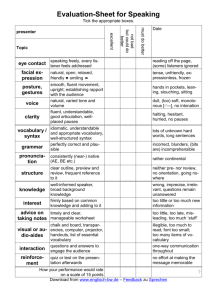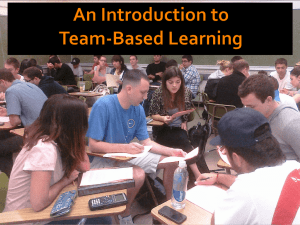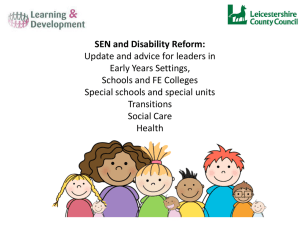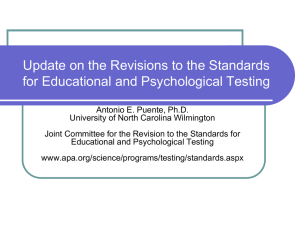Chapter 6: Methods of Collecting Data - ar
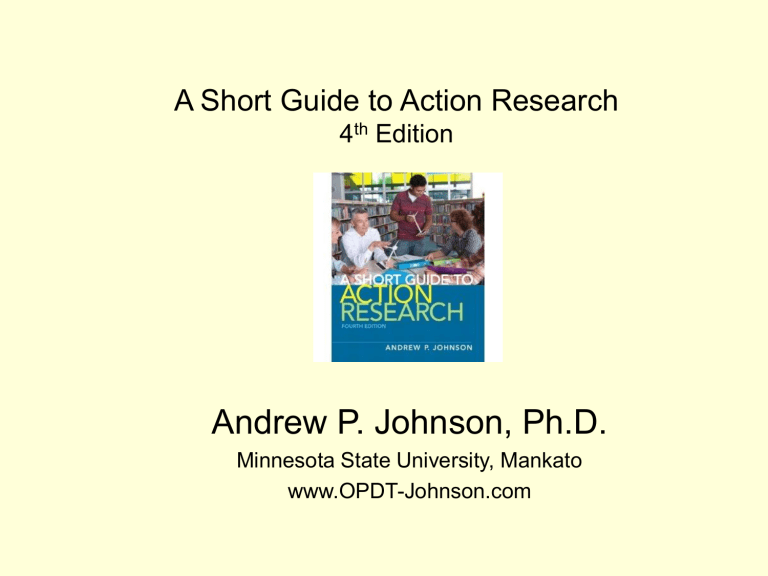
A Short Guide to Action Research
4
th
Edition
Andrew P. Johnson, Ph.D.
Minnesota State University, Mankato www.OPDT-Johnson.com
Chapter 6: Methods of Collecting
Data
DATA COLLECTION
Action research is systematic
A plan in place before the research begins
Plan describes what data you will collect and when, how, and how often you will collect them
Checklist to ensure regular data collection
Type of Data
Individual quiz scores
Dates Collected
8/18 8/25 9/2 9/9 9/16
Audiotapes
Student writing samples
8/13 8/19 8/26 9/2 9/17
8/17 9/9 10/1
Homework 8/17 8/18 8/23 8/27 9/2 9/10 9/16
Student journals 8/27 9/17
Small-group conference/focus group
8/20 8/27 9/3 9/10 9/17
1. Data collection like taking soil samples
2. Like a television sports analyst, you are the lens through which this bit of reality is perceived.
3. You must be unbiased, credible, and descriptive
TYPES OF DATA COLLECTION IN ACTION RESEARCH
1
. Log or research journal
2. Field notes
3. Checklists
4. Rating checklists
5.Rubrics
6. Conferences and interviews
7. Video and audio recordings
8. Data retrieval charts
9. Maps
10. The arts
11. Archival data
12. Surveys
13. Attitude and rating scales
14. Online platforms and class journals
Weekly Checklist for September 2010
At the end of each class, put a tally mark beside any activities done in that session.
Generating/prewriting
Drafting
Revising
Editing
Conferencing/talking
Reading
Other
Writing topics:
Special skills learned or used:
Things I have questions about:
Writing Checklist for Second- and Third-Grade Students
Student: ____________________________
Describe the student’s progress using the following key
: 3 = very much, 2 = some, 1 = very little, 0 = not at all.
Attributes
1. Uses invented spelling to hold ideas
2. Can spell most words on the 100 MFW list
3. Uses capital letters for beginning of sentences
4. Uses periods and question marks
5. Displays a willing attitude toward writing activities
Words per fifty (WPF) spelling scores:
Dates
Observations or comments:
Teacher Checklist to Document Skills/Concepts Taught.
Key: I = introduced, L = learning, P = practice/reinforce
Dates Taught
10/13 10/15 10/30 11/1 u y i o a e
Skill
SHORT VOWELS
I L L
P
I
Writing Skills
Capitalization of names
There versus their
Adjectives
Writing dialogue
Paragraphs
Commas
Open-Ended Checklist
Explanation of How You Use Each Skill
Rating Checklist for Science Skills
Student: _______________________
Teacher: ______________________
Grade: ____________
Science Skills
Key : 4 = outstanding, 3 = very good, 2 = average, 1 = low
STUDENT SKILL
Observe and describe
Create a graph
Weighing
Predicting
TEACHER
Organize data—create groups
Conclude
Use a lab report
Comments:
Rubric
1. Eye contact
2. Inflection and pauses
3. Structure
4. Preparation
4 = well above criteria 3 = meets all criteria
Maintains eye contact with audience throughout the speech, focus includes all audience members
Uses inflection and pauses effectively to maintain interest and attention.
Structure is very apparent and is used to organize ideas, all ideas within a section are related
Draft looked like a finished product, handed in on due date, all revisions were made
Eye contact with audience in most of the speech, focus includes most audience members
Uses some inflection and pauses to maintain interest and attention.
Structure is apparent and is used to organize ideas, most ideas within a section are related
Draft was mostly complete, handed in on time, some revisions were made.
2 = meets some criteria
Eye contact with audience in some of the speech, shifts focus to include some audience members
Uses little inflection and pauses to main interest and attention
1 = meets few criteria
Maintains little eye contact with audience, shifts focus to include audience members
Uses a flat, monotone voice with no pauses throughout
Some structure is used to organize ideas, some ideas within each section are related
Draft had some important parts included, handed in near the due date, few revisions were made.
Little or no structure is used to organize ideas, few ideas within each section are related.
Draft was incomplete, handed in late, few or no revisions were made.
Product and Performance Assessment Form
Student:_________________________________ Age:__________
Grade:________
Type of Product or Performance: __________________________
Key: 5 = very high, 4 = high, 3 = average, 2 = low, 1 = very low
When compared to other students of a similar age, rate the product or performance on the following criteria:
1.
Creativity ____
2.
Integration of ideas ___
3.
Technical merit ___
4.
Sophistication and level of detail ___
5.
Aesthetics: artistic expression, emotion, feeling ___
6.
Overall effect ___
Comments:
Writing Assessment Form
Writing prompt:
Key: 5 = very high, 4 = high, 3 = average, 2 = low, 1 = very low content, ideas _____ mechanics: spelling, grammar, punctuation _____ met deadlines; fulfilled assignment requirements
_____ organization, structure _____ fluency, communication _____ appearance _____
Ideas or insights:
Skills to work on:
Checklist for Independent Research Projects
Key: 3 = trait is present to a high degree, 2 = trait is present, 1 = trait is present to a low degree, 0 = trait is not present
___ A question was asked, a problem was identified, or an area of exploration was defined.
___ Data collection was systematic.
___ Data was analyzed in a way that made it credible and trustworthy.
___ The results were described clearly and accurately.
___ Recommendations or conclusions were made based on the results.
___ The research project was linked to a theoretical context (or background information).
___ The research was communicated in a way that was understandable.
___ Met all deadlines and requirements.
Research topic or focus:
Major results and conclusions:
Attitude Scales
Key: SA = strongly agree, A = agree, NO = no opinion, D = disagree, SD = strongly disagree
Reading is fun. SA . . . A . . . NO . . . D . . . SD
Key: 5 = strongly agree, 4 = agree, 3 = no opinion, 2 = disagree, 1 = strongly disagree
1. Reading is fun.
5 . . . 4 . . . 3 . . . 2 . . . 1
2. I know how to use science skills. 5 . . . 4 . . . 3 . . . 2 . . . 1
I like to read: very much , some , little
Key: 4 = often, 3 = some, 2 = little, 1 = not at all
1. I read at home each day.
4 . . . 3 . . . 2 . . . 1
2. I watch TV at home each day.
4 . . . 3 . . . 2 . . . 1
3. I complete my homework at school. 4 . . . 3 . . . 2 . . . 1
4. I use some sort of prewriting strategy.
4 . . . 3 . . . 2 . . . 1
